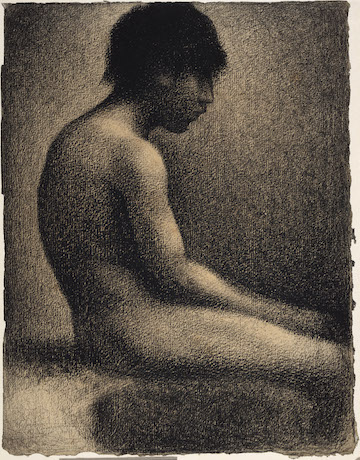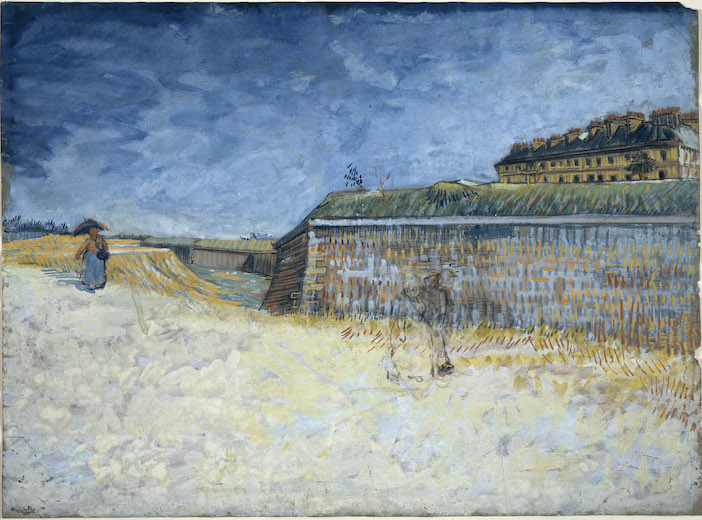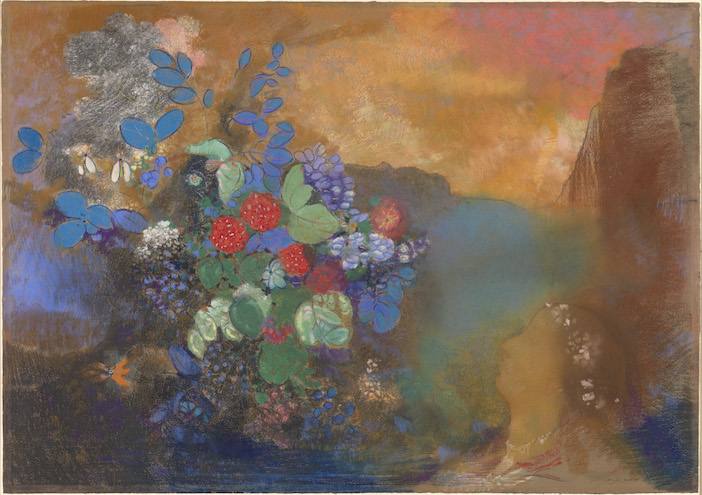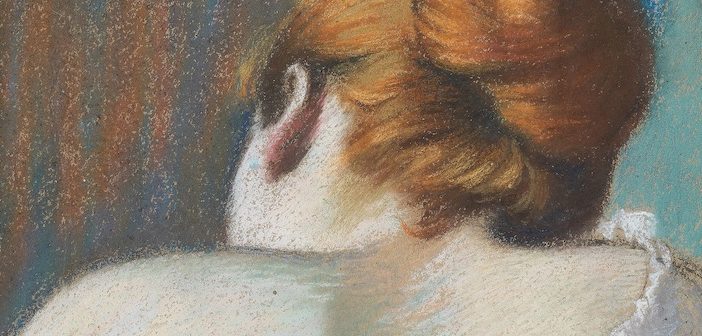Colour is the first impression that hits the senses on entering the Gabrielle Jungels-Winkler Galleries at the Royal Academy to see ‘Impressionists on Paper: Degas to Toulouse-Lautrec’. Easily spotted across the first gallery space is Edgar Degas’ vividly colourful Dancer Seen from Behind (c.1873) created in essence (diluted oil paint), on a bright raspberry-coloured, pink prepared paper. Right next to it is his equally riveting Dancer Yawning (Dancer Stretching), from the same year, also painted in essence on a lush, green prepared paperboard.
The two works capture the essence (pun not intended) of what this exhibition is about. The elevation and gaining popularity of works on paper in France from the 1870s through artists’ access to new art materials; commercially-made paper and paperboard – cheaper than handmade paper – in a variety of colours, pure colour pigment in portable metal tubes, conté crayons, chalks, graphite, charcoals, gouache, tempera and watercolours that were easier to use en plein air, to capture a fleeting moment, all gave artists a new freedom of movement.

Georges Seurat, Seated Youth, Study for ‘Bathers at Asnières’, 1883. Black conté crayon on laid paper. National Galleries of Scotland.
What has been less well-known is how the new materials elevated artists’ drawings into collectable artworks. This is explored in the exhibition. So popular did drawings become that many preparatory studies would be framed alongside the finished painting as a separate work of art in galleries. And artists capitalised on it. An outstanding drawing in the exhibition, an example of the highly finished drawings that were studies for paintings, is Georges Seurat’s Seated Youth, Study for Bathers at Asnières (1883) in black conté crayon on laid paper.
Seurat was an excellent draughtsman. He drew the figure from a live model in his studio. It is exact in form to the figure in the painting in oils at the National Gallery, but so different in texture, and atmosphere. It is a separate work of art, but which complements the finished painting. The resulting works created by artists in and out of the studio were progressive, experimental and collectable. Artistic innovation generated a demand for works on paper, from art collectors and the wider public, particularly drawings and watercolours created during the last three decades of the nineteenth century.
In France, in the early 1870s an artists’ group broke away from the theoretical and practical art formalities of the French state Salon. They called themselves the Indépendants, but were given the nickname ‘Impressionists’ at their first show in Paris in 1874, after Claude Monet’s painting Impression Sunrise failed to impress a critic. In the eight indépendants’ shows held between 1874 and 1886, amongst the founding members, so well-known today, were Monet, Cezanne, Berthe Morisot, Renoir and Degas, exhibiting the work they wanted to make. The RA show includes their works and adds lesser mainstream names such as the Venetian-born Federico Zandomeneghi, who exhibited at four of the Impressionist shows. His fabulous drawings are in this show, including Study of a Woman from Behind (1890-97) created in pastel on cardboard.
The RA exhibition has taken three and a half years to prepare. Its chief curators Ann Dumas and Christopher Lloyd spent much time in negotiation, persuading museums, galleries and private collectors to lend works on paper that are extremely fragile and rarely on show. The result – using low lighting levels in the gallery – is spectacular. There are gems here. Mary Cassatt’s 1894 Portrait de Marie-Thérèse Gaillard in pastel on paper, and Vincent van Gogh’s The Fortifications of Paris with Houses (1887) created in graphite, black chalk, watercolour and gouache on paper, show the diversity and wide-ranging breadth of artists’ creativity using different art materials.

Vincent van Gogh, The Fortifications of Paris with Houses, 1887. Graphite, black chalk, watercolour and gouache on paper. Photo: © The Whitworth, The University of Manchester. Photography: Michael Pollard.
And there are drawings for fan-designs, too; a fashion trend in Paris, instigated by Japanese fans. The exhibition has several examples, including Design for a Fan Featuring a Landscape and a Statue of the Goddess Hina, (1900–03) by Paul Gauguin, in watercolour and gouache, with touches of pen and black ink, over traces of graphite on a cream Japanese paper, pieced and laid down on cream wove paper. Each scenic fan design on show is exquisite in its remarkable detail, and pinpoints French high-fashion trends.
At the Circus: The Encore in black and coloured chalks on paper, by Henri de Toulouse-Lautrec and Odilon Redon’s near opalescent Ophelia Among the Flowers, in pastels, are two of the many later works in the show, recognising that the popularity of drawings on paper had not diminished. But not to miss is landscape painter Eugène Boudin’s striated Sunset over the Sea (c.1860-70) in pastels on buff paper. One of the earliest works on show, it is a precursor to impressionism that captures the nuances of changing light.

Odilon Redon, Ophelia Among the Flowers, c. 1905-08. The National Gallery, London. Bought with a contribution from the Art Fund, 1977. Photo: © The National Gallery, London
Add to this Armand Guillaumin’s 1872 work, Landscape with Trees and Rocks with Colour Tests, in pastel on laid paper who, alongside Degas and Boudin, found the medium of pastel perfect for capturing luminosity in sea and skyscapes. The colour tests at the side of Guillaumin’s drawing partly reveal his working methods. Another of Boudin’s works, Sky Study, from 1869, is near abstract in concept. In these works on paper both Boudin and Guillaumin pre-empt the art of Mark Rothko and Jackson Pollock, created eighty years later.
These artists really were not just of their time, but ahead of it.
Impressionists on Paper: Degas to Toulouse-Lautrec opened at Royal Academy of Arts, London, on 25th November 2023 and runs until 10th March 2024. For more information, and for tickets, please visit www.royalacademy.org.uk.
Header image: Detail from Federico Zandomeneghi, Study of a Woman from Behind, 1890-97. Pastel on cardboard. Galleria D’Arte Moderna, Milan. Photo: © Comune di Milano




